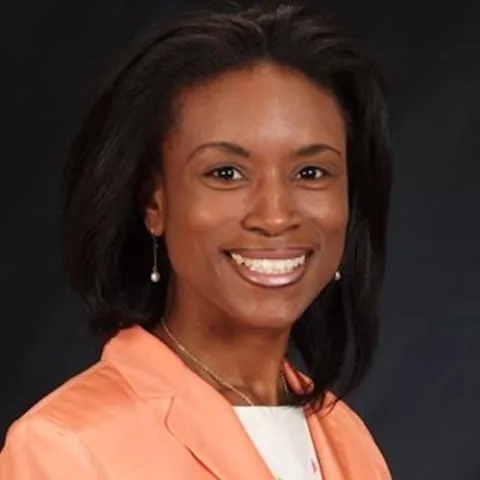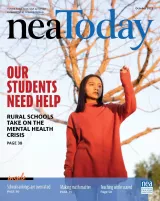Key Takeaways
- Some NEA members are teaching math through a social justice lens or in partnership with ethnic studies.
- Many are ensuring that students' questions and interests drive real-world lessons that are fun and engaging.
- One math teacher calls math a prism—something to look at the world through. Another calls it a tool—a way to investigate and solve problems. Either way, they're empowering students.
The stereotypical question on a standardized math test goes something like, “You’re in a hot-air balloon and you’re traveling … ” Ugh. Who cares? “None of my students have been in a damn hot-air balloon!” says Louisville, Ky., math teacher Kumar Rashad.
This is the problem with a lot of math education. Despite decades of effort to make it more relevant to students, to be more about concepts than computation, not much has changed. This century’s “new math” is a lot like last century’s old math. Boring.
It’s time for a fresh approach, say many NEA members. Whether it’s teaching math through ethnic studies or with a social justice lens, or asking real-world questions that pique curiosity and enthusiasm, math education needs to become more interesting.
More fun, too.
Creating Purpose
A decade ago, Karim Ani was attending a town hall meeting about the Affordable Care Act, listening to Northern Virginians lose their heads, when he had a small epiphany. “If we could have this conversation through what is fundamentally sixth-grade math, we wouldn’t necessarily agree, but the conversation would be much more constructive!”
That realization changed the way he thought about math education. “I’d been treating math as something to look at, when it should be something to look with,” says Ani, author of Dear Citizen Math: How Math Class Can Inspire a More Rational and Respectful Society.
Today, Ani’s learning platform, Citizen Math, provides teachers in grades 6–12 with two-day lesson plans that ask questions like, “Should the government increase the minimum wage?” (Or the most popular one: “Should people with small feet pay less for shoes?”) Most often, there isn’t a right answer, Ani says.
“For us, [the question is] more about do you enjoy the act of learning,” says Ani. “Are you getting better at analyzing issues? Do you see a purpose in school?”
Creating Better People
Ani calls math a prism—something to look through. Rashad calls it a tool. In his classes at Breckenridge Metropolitan High School, Rashad asks students to dive into the school district’s COVID-19 data or actual Louisville neighborhood crime stats and create multiyear projections.
Do they see linear growth? Or is it exponential? From there, they talk about policy solutions that might help keep them safe.

His goal isn’t to create better math students. “It’s to create better people,” he says.
Rashad sees a few—maybe more than a few— problems with math education in the U.S. For one, it’s too compartmentalized.
“There’s no reason you can’t teach math and science simultaneously,” he points out. For another, he adds, it’s too focused on teaching to the standards. Or, in other words, to teaching to the test.
“We should treat it as a tool to solve local issues,” says Rashad, who is also a local Metro Council member.
Nearly nine of 10 Breckenridge students are Black, and Rashad frequently uses math to address social and racial justice issues. He’s not alone in thinking that math can—and should—be taught through a social justice lens.
Creating Activists
In DeAndrea Jones’ preschool classroom, math is viewed through a social and racial justice lens because Jones views everything through a social and racial justice lens. That is who she is. That is her lens on life.
For her, this doesn’t just affect what she teaches—although she does have math lessons that enliven Black history. It also shapes how she teaches her 4-year-olds. Her students’ interests and questions drive her classroom activities.
“Much of mathematics teaching is listening to children’s thinking and allowing the children’s questions and thoughts to drive the discussion,” she says. In this way, Jones ensures her students know they have a voice.
She also makes sure they have fun. When young students engage in play, they’re more likely to employ “non-routine problem-solving” and practice perseverance, Jones says.

Too few teachers understand the importance of letting students lead, especially at the elementary level, says Marian Dingle, a former Georgia teacher who provides professional development on math education. Dingle spent the first weeks of every year asking students a million questions. Their answers guided her curricula.
“I lean toward curriculum that is generated or co-generated with students, with teachers, with communities—things generated out of students’ interests,” she says.
But it’s not just curricula. When you teach math through ethnic studies, “It encompasses actual pedagogical teaching practices and the ways we assess students,” says Seattle teacher Shraddha Shirude.
In Shirude’s classroom, students are free to make mistakes. “Students are free to correct the teacher. They can say ‘I disagree and this is why,’ and it becomes a critical conversation,” says Shirude. “The purpose … is to create critical thinkers who challenge the world. We see that in English and history classes—but we don’t see it as often in STEM classes.”
For Shirude, who also is a curriculum director at Washington Ethnic Studies Now, this often means project-based learning. Her students look at math transformations—like rotation and reflection— through shapes found in indigenous plants. They learn about symmetry and congruence and similarity through a unit inspired by the AIDS quilt.
And, like Dingle, Shirude works collaboratively.
“My curriculum is co-constructed with colleagues, students, and family members,” she says. “If you’re doing it alone, it’s not ethnic studies.”
Creating Educators
As part of Black History Month lessons, Jones used to have students simulate Harriet Tubman’s rescues of enslaved people. Using mathematical language, spatial thinking, and measurement, her 4-year-olds created “pathways to freedom.” For example, “Take five steps under the circular table … then turn right at the filing table to freedom!” Math plus Black history equaled fun.
But this lesson wouldn’t work for every teacher, Jones acknowledges. Jones is a Black woman who has taught at the same school for 20-plus years. She knows her community. Parents equally know and respect her. When Jones wrote about this activity in a math journal, and White teachers copied it, she says, “some got pushback.”
Similarly, while Dingle taught through a social justice lens, she doesn’t recommend it for everyone. “Can you define social justice? Can you defend it? I would start with the inner work … If you can’t practice social justice in your personal life, if you can’t point to it in your personal life, you have no business practicing it with kids,” she warns.
Get good training, Shirude urges. Look to experienced educators and community resources. And be brave, she says. People often fear incorporating ethnic studies into math, she says.
“There’s this fear that it takes something away,” she explains. “But it’s less about adding [ethnic studies] to math curriculum and more about figuring out why we teach it.”
Unlike those standardized tests that frustrate Rashad, this approach addresses the most essential question, says Shirude. It’s this: “Why do we give a f*#$ about math?”



